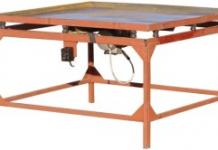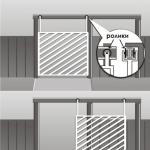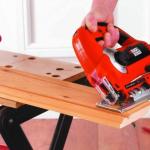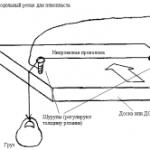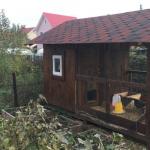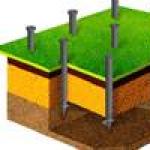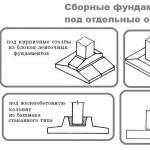One effective way to control pests is to attract birds to the garden. And the best way to solve this problem is considered to be the placement of houses for birds, in particular titmouses, on the territory of the site, since the tit (great tit and other species) is the most useful bird in the fight against garden pests in the Moscow region, and it easily populates artificial nesting sites.
We will tell you in this article how to properly make a titmouse with your own hands and attract beneficial birds to the garden.
Materials for titmouse
Fresh planed boards and boards coated with paint or impregnation are not suitable for building a titmouse. The strong smell can scare away birds.
The best building material for creating birdhouses with your own hands is considered to be untreated boards that have a characteristic gray color. Artificial nesting sites made from such “natural” material are readily inhabited by birds. Of course, old boards must be strong without rot, without through holes and cracks.
Titmouse design
The titmouse consists of four walls, a bottom and a roof.
The optimal height of the walls of the titmouse is 280-300mm, width 120-140mm. The height of the birdhouse is dictated by safety. Less deep artificial nests can be destroyed by predators (birds of prey, cats and others).
On front wall The titmouse needs to make an entrance. Optimal diameter taphole for tit 30-35mm. This size will provide protection from predators and increase the likelihood that the house will be inhabited by tits. The distance from the roof to the top edge of the tap hole should be 35-50mm.
The hole for the tap hole can be made with a milling cutter or a special drill, or knocked out with a chisel after first drilling holes around the perimeter. The edges of the taphole do not have to be perfect.
It makes no sense to equip the entrance with a special perch, since tits, like most other birds, do not use it, but such a stand will make it easier for predators to access the nesting area.
On the inside of the front wall, from the very bottom to the entrance, it is necessary to create a rough surface along which it will be convenient for the birds to climb to the exit. This roughness can be made using a drill or using a special ladder made of thin glazing beads.
Bottom must be removable, since the titmouse must be cleaned annually. It is best to make the bottom two-layer. This will further protect the birdhouse from moisture and drafts. The size of the top layer should correspond to the area of the titmouse’s internal space, and the bottom layer should match the size of the total area of the artificial nesting box.
Roof The titmouse should be approximately 50mm longer than the bottom. The canopy will additionally cover the entrance, which the birds really like. Just like the bottom, the roof of the titmouse can, although not necessarily, be double-layered. Such a roof, if it is tightly inserted from above and does not fly off from a gust of wind, can not be screwed to the walls and can be left removable.
Titmouse assembly
After all the parts are made, you can begin assembling the birdhouse.
To connect parts, it is better to use self-tapping screws or self-tapping screws rather than nails, which eventually cease to securely hold the wood together. In order not to split the wooden parts when tightening the screws, it is recommended to first make holes in the fastening points with a drill whose diameter is half the diameter of the screw. For convenience, when assembling the titmouse, you can use a screwdriver (instead of a screwdriver).
Assembling the titmouse begins by attaching two side walls to the back wall, then installing the front wall (with a pre-prepared entrance), bottom and roof. All parts should fit snugly together without large cracks or gaps. Otherwise, drafts may appear in the titmouse or moisture will enter it. This will definitely scare away the birds.
To attach the titmouse to the support, it is recommended to screw a special metal loop or a strong strip to the back wall, which can be tied to the tree trunk.
Titmouse decor is acceptable. The main thing is not to overdo it with decoration and not scare off future residents. Remember, you need beauty, and birds prefer simple and discreet homes.
Installing titmice in the garden
The titmouse can be hung on the walls of buildings and structures, on poles or on trees. The attachment to the support must be strong and reliable so that the house cannot fall and does not wobble under the influence of the wind. It is very important that birds feel safe in artificial nesting areas. The minimum height at which a titmouse can be placed is 3m.
When placing a titmouse in the garden, it should be taken into account that the entrance should be facing south or southeast. Birds most likely will not settle in houses that face north or west.
Titmouse care
During the cleaning process, you should carefully inspect the titmouse, if necessary, adjust the attachment to the support, tighten the screws, and in case of serious damage, repair it or replace it with a new one.
Colonization of the titmouse
Unfortunately, even correctly made and correctly installed titmice in the garden do not always populate the titmouse. The bird house may remain uninhabited or other birds may nest in it. If the titmouse has not settled, it is recommended to move it to another place. This can be done no more than once a year, outside the nesting period.
You can increase the likelihood of populating artificial nests by installing feeders with seeds and grain in the garden in winter. Birds that are accustomed to the feeding area in the spring will willingly settle in the houses they have built.
conclusions
1. Installing titmice will help attract beneficial titmice to the garden and reduce the number of pests.
2. To create bird houses, it is better to use old, untreated and unpainted boards.
3. Optimal dimensions of a titmouse: height - 350-400mm, width - 130-150mm, depth 170-200mm. The diameter of the taphole is 30-35mm. The distance from the roof to the entrance is 30-50mm. The protrusion of the roof visor from the entrance side is 50mm.
4. On the inside of the front wall it is necessary to make an artificial roughness or ladder to lift the birds to the entrance. The bottom of the titmouse should be removable, two-layer. The roof of the titmouse can also be double-layered and laid on the walls without fastening.
5. It is better to fasten the parts of the titmouse with self-tapping screws using a screwdriver.
6. It is not recommended to paint or decorate the birdhouse.
7. In a small garden, 2-3 titmouses should be placed at a distance of 20-50m from each other. Chickadees can be hung on walls, poles or trees at a height of at least 3m. The entrance should be facing south or southeast.
8. The titmouse must be cleared of nesting remains every year in winter or late autumn.
The titmouse will help attract little feathered helpers to your garden. After reading the article, you will learn how to make a titmouse with your own hands, where to install it and what important points you need to consider when making a titmouse.
The titmouse is one of the varieties of bird houses, so to speak, the younger brother of the birdhouse. And he is the youngest for two reasons. Firstly, smaller birds nest in it than starlings, and secondly, accordingly, it is smaller in size.
In the article about birdhouses, a few words were said about such a nesting site, but I want to once again draw attention to its features. It has, as a rule, a rectangular shape. Internal dimensions of the titmouse:
- height from bottom to roof approximately 25-30 cm,
- the side of the square bottom for small tits is about 10 cm, and for great tits, which often settle near people, the size of each side of the square bottom is better to be either 12 or 14 cm (14 cm is still better);
- The diameter of the entrance is 3-3.5 cm. For the great tit it is 3.5 cm. The entrance is located in the upper part of the house. See the table for the distance from the bottom to the tap hole.
Of course, not only tits can live in a titmouse, but also other birds of a similar size - sparrows, pygmy owls, whirligigs, redstarts, nuthatches, blue tits, pied flycatchers and others.
It is best to hang nesting boxes for tits in late March - early April at a distance of 3-8 m from the ground. Tits love darkness, so they will really like a house in a lush tree crown (especially for great tits). The titmouses themselves should be kept away from each other (no closer than 20m), otherwise you will create competition for food between the birds. The entrance should face west, unlike the birdhouse.
When you hang the titmouse, tilt it slightly forward. A tilted titmouse makes it easier for birds to get out of the house, and it is also more protected from attacks by cats.
So, how to build a titmouse?
To do this you will need the following tools:
- hammer;
- hacksaw, jigsaw;
- drill with a hole saw (if you don’t have a hole saw, then below I’ll give advice on how to cut a hole without one);
- pencil, ruler, compass;
- sandpaper.
And here are the materials:
- boards, planed on one side, 2 cm thick (can be 2.5 cm, but then you need to make adjustments to the dimensions, as shown in the table);
- nails 4-4.5 cm long;
- rope or wire for fastening;
- stain (to darken the inside of the titmouse).
To make a titmouse you will need the following parts: front wall, back wall, 2 side walls, roof, roof sleeve, bottom, mounting strip.
Take the sizes of parts for different titmouses from the table. These dimensions are for boards 2 cm thick.

It is easy to make a titmouse with your own hands if the parts are prepared correctly. You already know the dimensions of the parts, all that remains is to prepare them. To do this, use a hacksaw to cut out the front, back and side walls, as well as the fastening bar. Next, we make the sleeve and bottom the same size, as well as the roof.
In the fastening bar, you need to make two through holes on the side with a drill (top and bottom) to insert a rope or wire into them.
Before you begin assembly, you need to cut out an “entrance” hole (that is, a tap hole) in the front wall. A drill and hole saw are best for this, but if you don't have them, you can make a hole with a regular drill and then use a jigsaw to cut out the required hole. Smooth the cut hole with sandpaper.
Remember that the boards on the inside of the nesting box must be rough so that it is convenient for the birds to get out of it. This is especially true for the front wall of the titmouse.
Another important point for tits is darkness in the titmouse. Therefore, the walls inside must be treated with stain.
Before “putting the house into operation,” that is, before installing the titmouse, you need to fill the bottom of the house with grass or wood dust (about 1.5 cm).
We take care of additional protection for titmice
Small birds are more susceptible than others to attacks by enemies such as cats and woodpeckers. Therefore, we should take care of the safety of our feathered friends in advance. Firstly, the roof canopy must be no shorter than 5 cm (the table shows exactly these roof sizes), then the cat will not reach the nest while sitting on the roof. To protect the house from a woodpecker, you can drive short nails (with the heads facing out) around the edge of the hole, then he will not be able to gouge the entrance and get inside. Another option is to make a rim around a wooden tap hole from a tin can. Such protection will help keep the titmouse intact, since the woodpecker will not chisel the metal.
In the article we’ll talk to you about how to make a titmouse - a convenient housing for ornamental birds, which are necessary in any summer cottage. We hope it will be very interesting and informative!
The titmouse is intended for birds such as tit, garden redstart, goldfinch, pied flycatcher and many other ornamental birds that will not allow a large number of pests to multiply and develop in your summer cottage. And they look just great.
How to make a titmouse
If you have a desire to have tits in your garden, attract them with comfort, and not with original compositions of a bird house. Be wary of using new building materials: birds simply will not survive in houses made of plywood, asbestos-cement pipe, roofing felt or baked clay during low temperatures. Moreover, plywood is quickly destroyed by rain.
How to make a titmouse correctly
If you think carefully, creating comfortable housing for beautiful and useful birds is not difficult for a simple gardener. Such birds will happily settle in a wooden house with a horizontal roof (the titmouse is usually hung on a tree with a slight slope forward - which is enough for water to drain). There is no need to plan the workpieces; the titmouse will not be able to climb on the smooth and slippery walls inside the house.
Drawing of a titmouse with dimensions (Great and Triangular titmouse)
It is best to use not a board for the roof of a house, but a slab directly along with the bark. For convenient internal cleaning, the roof of the house is removable. It is necessary to clean when you are completely sure that there is no one in the house. A bedding of sawdust or dust, up to 2 cm thick, is laid on the floor.
 Scheme of wooden titmouses with dimensions
Scheme of wooden titmouses with dimensions 
It is not necessary to make a shelf under the entrance (entrance for birds) - birds cope well without it, but for cats and crows it will serve as a good support.
To help the birds
So that the birds can build their own housing according to their taste, make a titmouse with lattice walls. Put something like cotton wool, tow, dry grass in it and hang it on the intended tree. In the process of life, to build a nest, tits pluck wool from animals and all kinds of suitable materials. Now they don’t have to do this, everything has been prepared in advance by your hands right there in the garden.
How to hang a titmouse
There is no point in nailing the house to a living tree. You just need to tie it to the trunk with thin wire. It would be even better if you attach the house with a plank. To the ends behind the titmouse, closer to the roof, you need to nail a plank that will hold the house in the fork of the tree branches. To hang the house, you need to pry it with a pole with a nail nailed into it at the end at the entrance (entrance for the bird) and hang it in any spear on the tree you like. A house made in this way can then be easily removed for moving to another place or for preventative cleaning. In order not to damage the tree branches, the edges of the plank itself must be wrapped in soft material or the edges must be given a round shape.

Tin from cats
Cover the pole on which you hung the birdhouse at chest level with a sheet of tin for 1 meter. Cats will not be able to climb over slippery tin, thus reducing the threat to the chicks. If you don’t find a piece of tin, wrap the pole with barbed wire. Such methods are also good for protecting nests in trees. Use them with caution so as not to harm the tree or prevent the trunk from further development.
- On a plot of 4-5 trees, one such house is enough.
- Do not point the entrance to the leeward side (where the wind often blows from). Point it south, southwest. Hang the titmouses at a height of 3-5 meters.
- During the winter it is necessary to constantly feed the birds until spring. Otherwise, they will die without finding food in their usual place.
- can be made from food boxes or bottles that need to be washed thoroughly. Cover the neck with a lid, cut an entrance in the bottom and hang it horizontally. In winter, feeding from such a feeder, the birds look for a home nearby. Tits do not forget where they were fed in the summer and willingly settle on the site.

Signal for tits
It is very easy to set tits on pests. Anoint the bark of trees with pests with non-salted melted lard. Tits are very attracted to this smell; they quickly flock to the treat and quickly pick up all the pests.
The master class was conducted by Maria Yarovitsyna.
In winter, tits fearlessly wait out the frosts with us, and in spring, with their bright colors, they give us hope that spring will come soon.
A master class with step-by-step photos will show you how to make a titmouse.
Materials:
acrylic threads in dark blue, white, blue, gray, light yellow, bright yellow, gray-green;
scissors, glue, hook;
beads;
plastic rings with a diameter of 3.5 and 5 cm for making pompoms;
a piece of gray felt;
needles - large and small.
How to make a tit toy from pompoms.
Head.Wrap a dark blue skein around a ring with a diameter of 3.5 cm, pulling the threads through with a hook if necessary.
 1
1
When the dark blue skein runs out, the ring will be one third full (Fig. 1a). For the “cheeks”, divide the white skein in half and wind the threads around the ring on both sides so that there is a gap between them (Fig. 16). Wrap the entire template with two blue skeins (Fig. 1c).
 2
2

Cut the threads along the edge of the ring and create volume.
 3
3
Pull a strong thread through the center of the pompom in advance. When the blank for the titmouse's head is formed, tighten the thread tightly and only then remove the part from the plastic ring.
 4
4
Body, tail and wings.
For the body of the bird, fill a ring with a diameter of 5 cm one third with one grey-green skein (Fig. 2a). Take two blue skeins: start winding one around the ring, overlapping a segment filled with gray-green threads, and lay it along the ring in a thin layer - this is the titmouse’s “tie”.
 5
5

Wind the other skein on the other side of the gray-green segment, also with an overlap, but much tighter and shorter - this will be the tail (Fig. 26).
 6
6
Cover the entire blue segment from the “tie” side and half from the tail side with light yellow threads (Fig. 2c).
 7
7
Cover the entire light yellow segment with two bright yellow skeins (Fig. 2d).
 8
8
For the wings, wrap one gray skein over the blue segment, grab part of the gray-green segment and a little bright yellow (Fig. 2e).
 9
9
Wrap another 2-3 light yellow skeins around the workpiece so that only the gray segments of the future wings remain uncovered. Finish the circle tightly (Fig. 2e).
The further you move from the city, the more clearly you can hear the singing of birds. Often, even in the countryside, you can hear and see small birds, which not only entertain with their vocals, but also actively and almost imperceptibly help in the fight against pests. An owner who knows has a healthy garden and good feathered companions on the site.
Why do you need to make a titmouse in the country?
The thing is that tits as companions are very useful for garden trees and vegetable crops.
Tit is a generalized name for several representatives of the passerine order and the tit family. In our latitudes, the most recognizable species are the great tit, black tit or black tit, as well as chickadees and blue tits. Their habitat is quite wide. Some species prefer to settle in forests, others have better adapted to the conditions of populated areas and find places for nests near houses, for example, in garden trees.
The tit is difficult to confuse with another bird due to its bright contrasting color. The bird's sides are yellow, it has a black or dark gray cap on its head, and white “cheeks.” Tits are small birds, distant relatives of sparrows (part of the passerine order). The body length of different species varies between 8-18 cm, and the weight rarely reaches 25 grams (on average 14-18 grams).
Tit family
During the breeding season, tits feed on a variety of beetles, caterpillars and other insects, most of which are considered garden pests. Therefore, for any summer resident, making a titmouse out of wood with your own hands is a great idea to save your own energy.
In nature, tits choose hollows of various trees for nesting. However, they can also live in a specially made house on a cultivated tree (apple tree, pear tree, etc.).
For those who visit the dacha with children, making a titmouse with your own hands will not be at all difficult, but it will be entertaining and even fun. In addition, we can simultaneously teach the younger generation to love and respect nature. And further observations of the settlers will train attentiveness and satisfy natural childish curiosity. So we recommend everyone to make a titmouse with their own hands. And not alone.
Why do you need to make a titmouse out of wood?
A house for tits should be made taking into account some of the characteristics of birds. Thus, the use of chipboard, fibreboard and other materials is not advisable. They contain various additives, including resins, which may adversely affect the health of settlers. In addition, the surface of these materials is smooth. When the chicks grow up, they will need to get out of the nest. And it will be very difficult to make your way along a flat wall. Therefore, before you make a titmouse with your own hands, you need to acquire scraps or whole wooden boards, at least one side of which, which is the future inner wall of the house, must be unplaned. You can even make notches yourself for easier movement of birds in the titmouse.
How to make a titmouse with your own hands from wood
Since tits are small birds, the house for them should be small. Titmouse, drawing and dimensions of which presented in the article, is done for the smallest representatives of the passerine order. This is a structure with rectangular walls, one round or square entrance and a pitched roof. You can also make a gable roof and provide additional protection from predators in the form of wire mesh. It all depends on the imagination of the master.
Small titmouse: drawing and dimensions
- The house has a square bottom and rectangular walls. The bottom dimensions are 9 by 9 cm, 10 by 10 cm is acceptable. For the walls, only wooden boards 20-32 cm long are taken, the taphole is made at a height of 16-17 cm from the bottom of the structure. The exit diameter is very small: from 2.8 to 3 cm.
- For a great tit, the dimensions of the titmouse should be larger: the bottom is 12 cm on a side, the minimum height of the walls is 25 cm, and the entrance is made 3-3.5 cm in diameter. Moreover, it is placed higher by 2-2.5 cm compared to the lesser titmouse.

How to make a titmouse with your own hands from wood

Titmouse drawing and dimensions
What other features does the titmouse have (the drawing and dimensions do not show them)
- The house must have a removable roof. This is done so that in the fall, when the birds leave the nesting area, they have the opportunity to clean the house. You can make it this way using curtains, or by decorating the inner lid. It is also desirable that the roof extends beyond the walls by 1-2 cm, and in front protrudes above the entrance by 4 cm.
- The roof can be made with a forward slope. In this case, the front wall will be smaller than the back.
- When making the back wall of a titmouse, two methods can be used to design the fastening: attach an additional block, the dimensions of which are 10-20 cm larger than the length of the wall. The fastener must have its tip facing outwards. The second option is to make the back wall longer, drill a hole in its upper part for a screw, or attach a ready-made mount.
- You cannot paint walls inside the house. But outside you can. It is better to choose natural colors: shades of gray, brown, green. To give it a greater resemblance to a natural hollow, the outside of the titmouse can be lightly coated with clay.
- The entrance can be made square and placed in the corner of the wall, closer to the roof.
- If the walls are made from more than one board, the bars must be tightly adjusted to each other to prevent drafts.
- It is easier to make a titmouse from soft wood (pine, larch). The thickness of the blanks is 1.5-2.5 cm.
What is needed to make a titmouse from wood with your own hands
- Wooden blanks (for walls, bottom, roof);
- Bar for fastening;
- Wood nails or screws;
- A feather drill, a wood crown or a simple drill;
- Drill or screwdriver;
- Paint (optional);
- Saw, hammer, coarse sandpaper.
To make a titmouse, the drawing and dimensions are transferred to wooden scraps or boards. The blanks are cut out. Then the walls are adjusted together. The tap hole is formed by drilling with a feather drill of the required diameter, or by drilling several holes with a regular drill and bringing the diameter to the desired type with a chisel and sandpaper. They fasten the walls and bottom, hang the roof.

How to make a titmouse with your own hands from wood
Making a titmouse with your own hands from wood is not as difficult a task as it might immediately seem. However, the right home is not everything. It is necessary to correctly install the titmouse on the tree.
To do this, choose the leeward side; it is advisable to direct the entrance for tits to the west.
You need to hang the titmouse quite high: at least 2.5 meters from the ground, and better yet even higher.
When fastening, the entire house must be slightly tilted towards the entrance.
This makes it easier for the chicks to be released into the wild. The titmouses need to be placed at a sufficient distance from each other. The distance between the houses is 15-20 m.
Green farming principle


